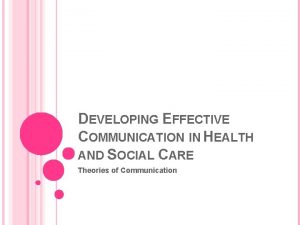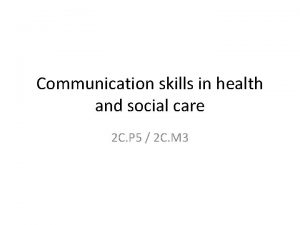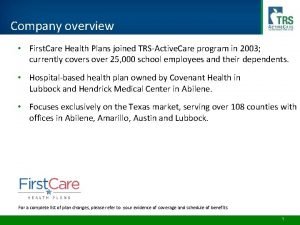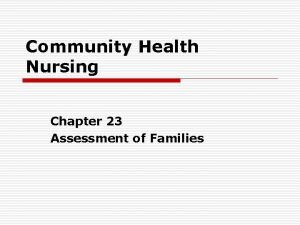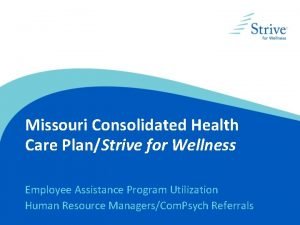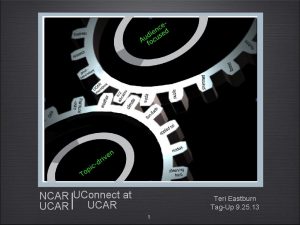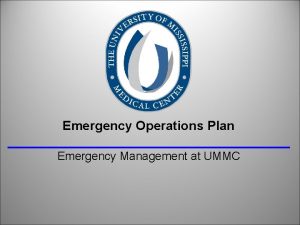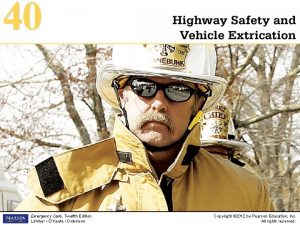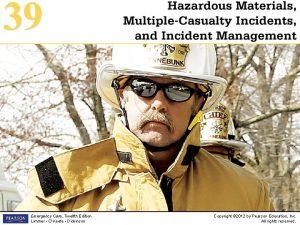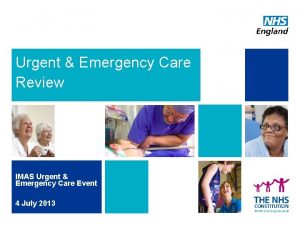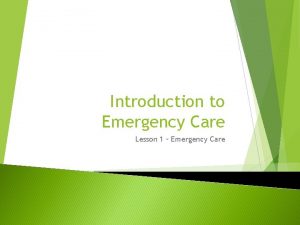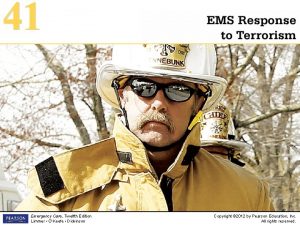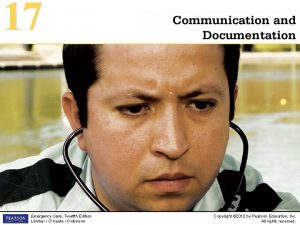HEALTH CARE EMERGENCY COMMUNICATION PLAN Shawn E Stoen














- Slides: 14

HEALTH CARE EMERGENCY COMMUNICATION PLAN Shawn E Stoen West Central MN Healthcare Preparedness Coalition Regional Healthcare Preparedness Coordinator

OBJECTIVES • Identify the components of the emergency plan that are required by CMS • Identify hints on building or developing your communications plan • Identify eight things your emergency plan should do • Understand the components necessary in a communications plan • Define HIPAA and its implications on emergency communication situations • Understand how HICS, communications, and the PIO work together • Discuss the role of communications in an emergency

CMS AND COMMUNICATION PLANS • Requires health care facilities have a stand alone communications plan that: • Includes names and contact information for: • Staff • Contracted agencies that conduct business within the facility (i. e. rehab services, beauty salon) • Physicians • Neighboring health care agencies (i. e. hospitals, clinics, long term care agencies) • County contacts (public health, law enforcement, fire, emergency medical services, mortuary) • Regional contacts (health care coalition) • State contacts (licensing agencies, • Volunteers

CMS requirements continued…… • Identifies how to contact staff and other contacts…. • To include the primary and back up processes • Who to contact and when to contact people/resources • Identifies how to release information to health care providers in the event of an evacuation • Discusses how to release information about the patients basic condition and location • A process for sharing the long term facilities status, including occupancy, ability to provide services to local emergency management, county partners, health care coalition, and state agencies • Identify how to update patients/families/responsible parties the status of the facility and the emergency plans that are in place/being utilized

HINTS ON DEVELOPING YOUR COMMUNICATION PLAN • Keep it simple • Be flexible • Easily accessible • Coordinate with other entities (local emergency management, law enforcement) • Review, test and practice • Utilize the Healthcare Incident Command System – Public Information Officer

8 THINGS YOUR COMMUNICATIONS PLAN SHOULD DO: • Launch quickly. • Brief leadership/management on the situation. • Identify the facilities Public Information Officer and their role in an emergency. • Processes that identify how to prepare and issue statements to the media and other organizations. • Organize, monitor, and facilitate media coverage including social media. • Communicate situation information and procedural instructions to employees and other stakeholders. • Communicate with employee/patient families and the local community. • Continually adapt to changing events associated with the emergency.

COMPONENTS OF A COMMUNICATIONS PLAN • Identify the types of communications available within your facility and how they will be used in the communications plan • Types of communications (radio, phone, computer, overhead paging) • Plain language – overhead paging • Who are the stakeholders and how to contact them and when to contact them • How to communicate with family members in an emergency • How to maintain contact lists, who is responsible for maintaining, how to use contact lists • Information sharing • With media • Family • Patients • Stakeholders/County/Region/State

HIPAA IN EMERGENCIES • HIPAA is designed to protect the patients rights to privacy however, it is also flexible enough to ensure that the community’s health is also protected • Information may be disclosed that ensures continued treatment – between health care providers • To public health agencies, MDH, CDC – when the information is used to protect or control the spread of disease to community members, EMS or first responders etc. • Imminent Danger – information can be disclosed to law enforcement/emergency management/fire departments and first responders - to identify location of a person at risk/needing assistance


HICS AND COMMUNICATIONS • Have someone with Public Information Officer training (online, Anniston, regional) • Utilize the job action sheets which identify responsibilities of the PIO • Works with other PIO’s in the event to create one consistent message • Create pre-scripted releases for media • Monitors media • Develop a working relationship with stakeholders, media, and emergency management

WHAT THE COMMUNICATIONS SECTION AND PUBLIC INFORMATION OFFICER WILL NEED…… • Telephones with dedicated or addressable lines for incoming calls and separate lines for outgoing calls • Access to any electronic notification system used to inform employees • Electronic mail (with access to “info@” inbox and ability to send messages) • Fax machine (one for receiving and one for sending) • Webmaster access to company website to post updates • Access to social media accounts • Access to local area network, secure remote server, message template library and printers

What the PIO/Communications Center needs continued……. . • Hard copies of emergency response, business continuity and crisis communications plan • Site and building diagrams, information related to business processes and loss prevention programs (e. g. , safety and health, property loss prevention, physical and information/cyber security, fleet safety, environmental management and product quality) • Copiers • Forms for documenting events as they unfold • Message boards (flipcharts, white boards, etc. ) • Pens, pencils, paper, clipboards and other stationery supplies

COMMUNICATION DURING AN EMERGENCY • Gather information • Monitor incoming calls • Coordinate messages • Monitor email/media/social media • Keep management/incident command updated on the situation • Provide/share information with patients, staff, families, community, law enforcement, media etc.

QUESTIONS?
 Primary secondary and tertiary health care
Primary secondary and tertiary health care Health and social care values unit 2
Health and social care values unit 2 Health and social component 3
Health and social component 3 Communication cycle health and social care
Communication cycle health and social care Theories of communication in health and social care
Theories of communication in health and social care Observation skills in health and social care
Observation skills in health and social care First care health plan
First care health plan Family care plan in community health nursing
Family care plan in community health nursing My mchcp
My mchcp Shawn steck
Shawn steck Ot vision 2025
Ot vision 2025 Iec standards
Iec standards Shawn beightol
Shawn beightol Shawn liotta
Shawn liotta Shawn winkleman
Shawn winkleman




